#Meta Marie Louise
Text
Meta Marie Louise @ Atomic Café

View On WordPress
0 notes
Text
A short but interesting interview with Louise Charbonnel from January! She talks about her vision of the character and how she prepped for the role so she wouldn't "copy" any previous singers OR Alex.
The most salient bits translated under the cut.
She's not "particularly interested" in musicals, but "this isn't a musical -- it's Starmania."
About MJ: "She watches where others are busy living and getting power, money, fame or love. MJ doesn't want anything, she says it: 'I just want to be left alone.' She isn't driven by anything, so she's just there, watching, thinking, drawing the right conclusions. She's in the shadow, no one cares about her, so she has time to take a step back."
About MJ being compared to a Greek choir: "She is the Greek choir but it's not a lament, she doesn't complain: these are the facts, this is how it is. "I don't know what I want to do with my life but I'm not lamenting that state of affairs," that's how I see her. That's what I like about MJ: her is neither a song of lament, not a light, superficial song. If it were a song of despair, she'd have been dead already, which she isn't! And if it were light, it wouldn't be MJ. She's such a strong character because she makes a very cold assessment of reality. She testifies to the audience about it. In the end, she isn't passionate about anything, except her boundless love of Ziggy."
Her father worked on arranging Michel Berger songs so she was familiar with the music.
About prepping for the role: "I listened to Starmania by various singers, which means I don't hear the ghost voice of Fabienne Thibeault. We were also lucky they didn't ask us to "do it like the original singers," which would have been impossible and with no added value. I worked from the sheet music instead of listening to the songs, so I could be sure not to fall into the trap of mimicry."
About being an understudy: "The other hard thing was not 'copying' Alex Montembault, who has a very personal way of playing the character. It involved a lot of creative research. I managed to find myself among all those personalities."
About the themes of Starmania: "It is absolutely a work of social science-fiction, and Thomas Jolly's current staging really underlines that. Whereas in previous versions there were aliens and the love story was the focus, this time, there is a clear choice to put the political campaign front and center."
2 notes
·
View notes
Note
How are your OCs' relationships with their mothers?
Oho, this is a good question because it varies from OC to OC - so I'll group similar ones together (and I'm putting them under the cut because I have a lot of OCs)
Several do not have great relationships with their mothers - Nicky's parents left her behind with relatives when she was six and she's very bitter about this, and still doesn't entirely believe that her aunt won't one day do the same. Sophie Sloan (Diagnosis Murder OC) was abandoned by her mother when she was two years old - she doesn't remember enough to miss her, but part of her can't help but feel it was a judgement on her. My X-Men OCs Alex, Rosa, and Kate left their respective homes because of their mothers' anti-mutant sentiments and there's no reconciliation on the horizon because unfortunately, that hasn't changed in the years since. Marie Douglas (The Professionals) and Brianna Louise Wilson (NCIS) left home at thirteen and eighteen respectively because they were unwanted compared to thier siblings and damn well knew it.
Steph Taylor and Brianna Thawne get along with their mothers but it is somewhat distant - Steph's worked a lot during her childhood and while she doesn't exactly begrudge her that there's still a little bit of resentment there, and they only tend to talk on holidays and birthdays. Brianna's loves her, but unintentionally put pressure on her by talking about the high achieving relatives, which made Brianna push herself and push herself until she burnt out, and then she left home at seventeen to find herself (and became a Blue Flame Wielder), and has hardly talked to her since. Risa Redlark (Superman Returns) talks to her mother but struggles to connect with her as she doesn't understand why Risa wants to be a journalist. Áine (The Witcher) doesn't see her mother much because she travels a lot, but still tries to make time to see her when she can.
Some of them had positive relationships with their mothers but are missing them for one reason or another. Meri Solo, Isla Tinero-Antilles and Ashley Tanner (my Krypton OC) loved their mothers, but lost them at a young age - out of the three, Ashley has more memories as she was ten (compared to Isla at 4 and Meri at 5), but sometimes suffers doubt about whether her mother would've accepted her gender identity had she lived, and that unanswered question colours things a bit.
Eliana's mother Lana Lang is presumed dead - nothing's ever been confirmed, as there's no way to contact her Earth, but Eliana is mostly convinced that she's dead, because there's no way that her mother wouldn't have been helping more metas and aliens get off-world and she would be killed if caught, and Eliana misses her so much but hardly allows herself to think of any possibility she might be alive because it's too painful (but nonetheless, a small part of her hopes.) Nellith does think her mother is dead because of the severed Force Bond and this devastates her and she struggles to talk about it with anyone - even Meri, the person who ends up looking after her for the next fourteen years.
Emile Brooke has been mostly raised by her grandparents and doesn't see her mother often - as of the start of the story it's been two years since she last saw her - but she doesn't doubt that she loves her, even with the complicated circumstances. Lissa Blackwood has not contacted her mother in fifteen years and although she feels so very guilty about this, is nonetheless convinced it is for the best.
The rest have pretty solid relationships with their mothers. The Barnes children all adore Leah, and look up to her a lot, Gemma Laura McKinney still regularly visits both her parents, and James Connors thinks Nicky is the best mom ever and he's so happy to have been adopted by her. Maia Curry only knows the one parent but that's enough for her and she's never felt unloved or been bothered by the lack of a father. Sophia Reynolds has been raised only by her mom for the last eleven years (because they had to flee their home planet and have no way of contacting Mal Reynolds to let him know they're alright), and is very protective of her mom.
Theo Thawne loves his mom Laura to pieces and even started studying to become a social worker like her. Sarah Thompson got along very well with her mother, and Alex always tried to find a way to talk to her mom when she could, unless she was on an undercover mission - even though there was still some disagreement over Alex joining SHIELD in the first place. Hannah Edwards is happy to be Jane's kid, and though she has a desire to find her birth father, she is not so bothered about finding out about her birth mother (she does eventually get to meet Bobbi, but it takes some time for the relationship to become cordial). Caitlin Sherwood (Buffyverse) speaks to her mother once a week and sees her when she can and gets along with her well, she's just often very busy. Niamh (OUAT) lives with both parents and is the light of their lives, Joanna (Uncharted) was mostly raised by her mother and maternal aunt and considers them as the most important people in the life, and Mel Hathaway (Star Trek) has a somewhat strained but mostly loving mother (she just disagreed with Mel joining Starfleet after she was nearly killed while on a routine trip to Vulcan).
As for the others I just haven't got that far.
Tagging (let me know if you want to be added or removed): @shrinkthisviolet @starstruckpurpledragon @vexic929 @negative-speedforce @lady-of-the-spirit
@fezwearingjellybananas @daughter-of-melpomene @forchrissy
7 notes
·
View notes
Note
Hi, it's me AGAIN !!!! But i'm obsessed with Lonely Eyes and I was wondering if you have a list of all the books/movies that Will recommended and talked about!!!!! If not i'll skim through it to find them all but i thought i'd ask!!! 🫀🫀🫀 have a lovely day 💗💗💗 (- June on ao3 ☺️)
JUNE!!! you've been brightening my week so much you've got no idea<3
I, too, am obsessed with LE, so compiling this was super fun for me ehehe. theres overlap on certain things because they're in multiple categories but eh so it goes. I THINK I got everything so far? I might have missed one or two but I tried lol
Books:
Pride and Prejudice by Jane Austen
The Exorcist by William Peter Blatty
Frankenstein by Mary Shelley (Will's favorite)
At the Mountains of Madness by H.P. Lovecraft
Val Lewton: The Reality of Terror by Joel E Siegel
Slaughterhouse Five by Kurt Vonnegut (chapter title reference only)
Movies:
Poltergeist (1982)
Invasion of the Body Snatchers (1978)
The Exorcist (1973)
The Evil Dead (1981)
The Evil Dead 2 (1987)
Alien (1979)
Lawnmower Man (1992)
The Thing (1982) (Will's Favorite)
Basic Instinct (1992)
Return of the Jedi (1983)
Little Shop of Horrors (1986)
Heathers (1989)
Carrie (1976)
Pretty in Pink (1986)
Poems:
The Kiss by Anne Sexton (Will's favorite)
Just Once by Anne Sexton
Beast I, original
Song in a Minor Key by Dorothy Parker
The Triumph of Achilles by Louise Gluck
Having a Coke with You by Frank O'Hara
Beast II, Original
Beast III, Original
To You by Frank O'Hara
Songs:
Sitting On Top of the World by Doc Watson
Forever Young by Alphaville
Landslide by Fleetwood Mac
Songs Referenced in Meta (ie chapter titles):
Lonely Eyes by The Front Bottoms
Freeze Your Brain, Big Fun and Seventeen from the musical Heathers
Forever Young by Alphaville
Sorry For Me by Ricky Montgomery
Landslide by Fleetwood Mac
High Time by Kacey Musgraves
#hannigram#hannibal#will graham#hannigram fanfiction#hannibal lecter#lonely eyes#ask#thank you for the message!!!
7 notes
·
View notes
Text
G Gundam meta notes part seven, eps 39-44:
"The Ruthless Fight! Schwarz's Last Match"
-Schwarz is Domon's "surrogate master", huh
-NO KILL LIKE OVERKILL, DAMN, WONG
-drop that bombshell, Dr Mikamura!
-Akino can GET IT
-the announcer is so chipper about such shitty circumstances, I love her
-it's okay, Rain, it makes sense that you wanna help even though you're mad at Domon - that Gundam is your baby
-there's a lot to dissect with this relationship in this episode specifically and I'm struggling with the words, but let's try
-from Domon's side, I can't help but notice his double-down eschewing of any support comes hot on the heels of his encounter with Master and being told that he should rely on his fists and not his emotions, so maybe he went too far the other way and took it as "right, emotional ties are stupid and get in the way"? Or tried to, anyway, because he's obviously very bad at this
-from Rain's end, although we want to shout at her for thinking she needs to apologize when Domon was the one being a jerk, her explanation tells us that this is the culmination of an issue she's been dealing with at least since Allenby's been on the scene
"Battle Royal Begins! Devil Gundam Revived"
-oh fuck me, Domon has such pretty brown eyes
-huh. It makes a certain kind of sense for someone going into a life-threatening situation to put off a love confession. Don't wanna admit to something you may not be around to act on
-"AND NASTASHA"
-okay that is some unsettling animation for the DG reemergence
-Mikamura was about to kill him!!
-okay, THIS is the juicy shit I'm here for! What starcrossed-families drama! What a petty reason to cause so much suffering for so many people!
"Assault of the Four Evil Kings! Gundam Heaven's Sword"
-I always giggle at sparkly Argo
-"C'mere, crazy bird! I'll make fried chicken outta ya!" He doesn't speak much, but it's priceless when he does
-Nastasha reacts immediately after getting told something's a bad omen. Between that and the bit in a previous episode about a shooting star being bad luck on the colony, I see our logician has a superstitious streak!
-hell yeah, Shirley! Use that… engineering? My science skills are lacking
"Royal Counterattack! Ambush of the Grand Gundam"
-"Stay alive!" gets me every fucking time
-"Helped by your friend again, I see. Still can't fight on your own!" See, this is the shit I was talking about!! Master Asia is putting some shitty ideas in Domon's head - and depending on how long he's felt this way about teams/friendships, was he a crappy Shuffle in his day? Or does he proclaim this because the Shuffle relationship fell apart?
-"how could I lose track of my bullets?" Gee, I wonder!!
-"in the arms of the woman I love" which is,,, who, exactly, bro? This feels a little gratuitously "have I mentioned I am heterosexual today" tbh, or a censoring of polyamory if you wanna go that route
-"I woulda socked you in your conceited pretty face" :)
-Marie-Louise has no fear of death, pass it on
-George is the Hulk
"Schwarz Rests in Grace! Domon's Tearful Attack"
-"simply too old for this" isn't he like fuckin 50
-Domon has an "obedient nature"
-this boy's life is tragedy upon tragedy
-"Allenby of the Darkness" okay Wong, I don't believe in cringe, but you're pushing it
-given the chance I could probably wax a little poetic on the 'crews with fallen fighters' shots
-this is another scene I have to watch peeking through my fingers, that red-hot pathos hits just right
"Farewell Master: Master Asia's Last Breath"
-It never fucking ends for Domon, does it
-Master bringing the worldbuilding themes together
-seriously, 'communicating with your fists' is so frickin cool!!
-Domon may not be at ease with his own emotions, but he's more perceptive than he realizes (though, I think I've said this before, only when he's paying attention)
-anything that is allowed to be unashamedly emotional and poetic, and show that those things aren't at odds with masculinity, makes me feel some kind of way
-y'all are foolhardy - did Sai get closer to the action?
-OM NOM GIMME THAT GOOD BLACK JOKER
-Lord Almighty, this is tragic for everyone involved and I am eating it up
2 notes
·
View notes
Text
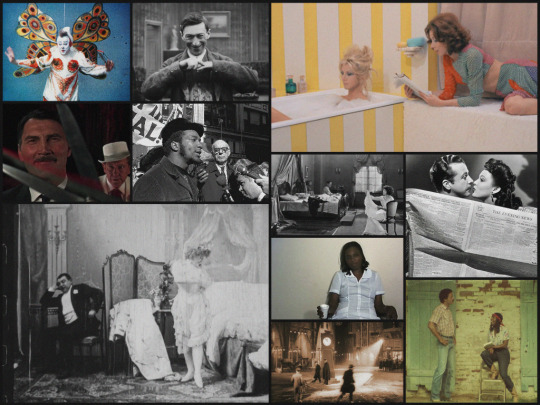
Favorite New-to-me Films
February ‘24
(listed in order of collage above, L to R)
READ on BELOW the JUMP!

The Clowns / I Clowns (1970)
[letterboxd | imdb | kanopy (US)]
Synopsis: Fellini delves into the world of European clowning, traveling with his crew to various capitals of clown culture. From a dramatization of his own challenging childhood experience with clowns to a barrage of performances by current clowns (in a variety of unique venues) and recreations of historical circus-based acts, Fellini creates a dizzying comedic portrait of an artform struggling to survive. (CW/TW: blackface, as seen in one recreation of a historical act.)
---

Gribouille redevient Boireau (1912)
[letterboxd | imdb]
Synopsis: In this meta short, French-born comedian André Deed dramatizes (or slapstick-izes) his move from Italy, where he made films as Cretinetti (Gribouille in France) for Itala, to France, where he would continue making shorts under the name Boireau. Cretinetti/Gribouille survives an altercation with the father of his sweetheart Valentina (Valentina Frascaroli), a run in with border patrol, an attempted kidnapping, a train hijacking and subsequent derailing, and being forced at gunpoint to make films for France. Now Boireau, he is rushed onto set where a bit more chaos ensues before he addresses the camera directly and assures us in pantomime that he will keep making films and that his heart is here in France.
---

Torture Garden (1967)
[letterboxd | imdb]
Synopsis: At an amusement park sideshow, a fiendish host, Dr. Diabolo (Burgess Meredith), selects a few of his guests to get a preview of their potential downfalls from Atropos, the Goddess of Destiny. The first customer (Michael Bryant) is warned away from victimizing his uncle and cutting an unholy deal with a demon cat. The second (Beverly Adams) has to look out for the consequences of too ruthlessly pursuing fame in Hollywood. Her cousin (Barbara Ewing) has to look out for a boy and his piano possessed by his dead mother. The final customer (Jack Palance) is an avid Poe fanboy who is at risk of taking his obsession too far. Dr. Diabolo is not a simple carny though, so these glimpses into their respective futures may give them an opportunity to change their fates.
---

The Murder of Fred Hampton (1971)
[letterboxd | imdb]
Synopsis: An unflinching look into the Chicago police’s vicious assassination of Fred Hampton but also a survey of some of the important antifascist work Hampton did with the Black Panthers in his final years.
---
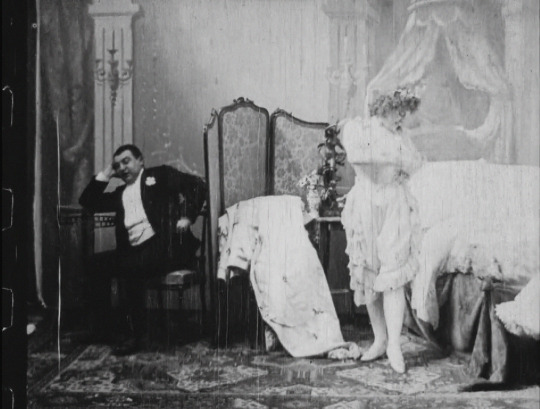
Bedtime for the Bride / Coucher de la mariée (1896)
[letterboxd | imdb]
Synopsis: A new bride (Louise Willy) disrobes before bed on her wedding night.
---
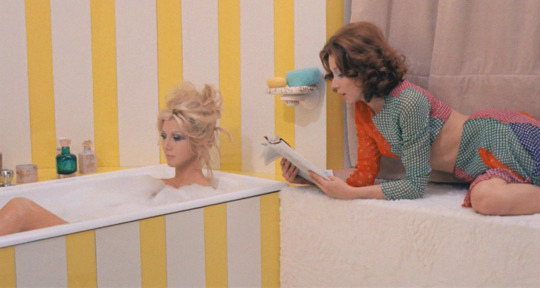
The Others / Le Altre (1969)
[letterboxd | imdb]
Synopsis: Alessandra & Flavia, a lesbian couple living in Rome, decide that they want to have a baby. The process of finding a suitable baby daddy is a series of misadventures but eventually Flavia becomes pregnant. Their relationship is tested but they build a happy home until the potential dads figure out what’s going on. The men want to turn their relationship into big news and an ad campaign; their private lives become public spectacle. Thankfully, Alessandra hatches a scheme to solve all their problems.
---
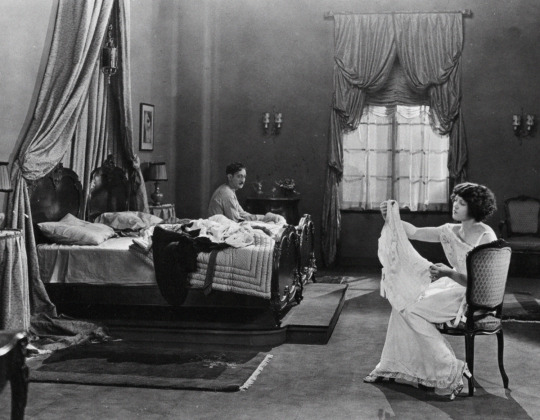
The Marriage Circle (1924)
[letterboxd | imdb]
Synopsis: The marriage of Mizzi and Dr. Josef Stock (Marie Prevost & Adolphe Menjou) is on the rocks. Josef hires a detective to gather enough evidence to secure a divorce. Meanwhile, Mizzi attempts a flirtation with Dr. Franz Braun (Monte Blue), who she soon finds out is the husband of an old friend, Charlotte (Florence Vidor). To complicate matters, Dr. Gustav Mueller (Creighton Hale), who is Franz’s business partner, is in love with Charlotte. A variety of schemes and misunderstandings ensue before the Stocks’ marriage dissolves and the Brauns’ marriage is saved.
---

It Happened Tomorrow (1944)
[letterboxd | imdb | tubi (US)]
Synopsis: An aspiring reporter, Larry Stevens (Dick Powell), thinks he would be set for life if he could see one day into the future. Larry’s wish is granted in an unexpected way when he gets a copy of the next day’s newspaper. Larry tries to make the most out of the situation while sparking up a romance with a phony psychic called Sylvia (Linda Darnell). It does not take long before Larry figures out that the scenario for success that he dreamed up may be a nightmare.
---

Personal Problems (1980)
[letterboxd | imdb | kanopy (US)]
Synopsis: A soap opera wrapped in a cinema-verité package, Personal Problems recounts a period in the life of Johnnie Mae (Vertamae Grosvenor), a nurse living in Harlem. Johnnie Mae tries to juggle her job as an ER nurse with an affair with a musician, tension with her husband (who is also having an affair), a father-in-law (who has overstayed his welcome), and a long-term visit from her brother and sister-in-law (who was just released from prison).
---

New Year’s Eve / Sylvester (1924)
[letterboxd | imdb]
Synopsis: In this wordless spectacle, a man tries to hold his household together after the antipathy between his mother and his wife boils over one New Year’s Eve.
---
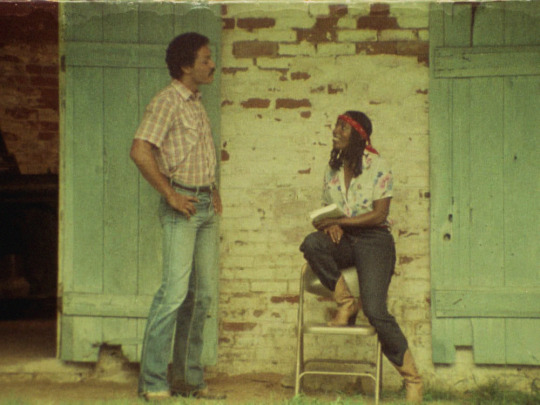
Cane River (1982)
[letterboxd | imdb | kanopy (US)]
Synopsis: Peter (Richard Romain) returns to his small hometown in Louisiana after trying to make something of himself in the big, wide world. When touring a local plantation, tied to his ancestry, he meets Maria (Tommye Myrick) and they begin a romance. However, Maria has saved up for years to leave Natchitoches and go to college and she plans on leaving soon to start school. Various complications arise in their relationship as their different backgrounds and ambitions come into stark contrast.
---
Honorable mention:
Léontine Keeps House / Léontine garde la maison (1912) [letterboxd | imdb]
Boireau et la gigolette (1912) [letterboxd | imdb]
---
This month, I watched a silly amount of silent comedy shorts because I’m reading Steve Massa’s Slapstick Divas and wanted to sort of watch along. I put together a little list of some of the highlights in case you all are also interested in the women of early silent comedy: “‘Film Comedy’s Eves’ Watchalong”
The next installment of Lost but Not Forgotten is a doozy, but it’ll be up very soon! In the meantime, I made a gifset of a few surviving minutes of A Lover’s Oath (1925).
Other themed gif and still sets I put together this month include:
Out of the Unknown: 1.01 No Place Like Earth (1965)
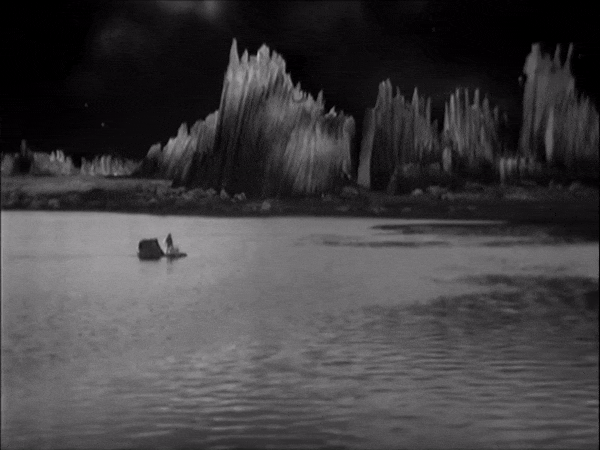
Eleven P.M. (1928)

The Ghost Ship (1943)

---
For March, I’ve got a little cosplay in the works in addition to the next entry in my LbNF series. So stay tuned!
☕ Appreciate my work? Buy me a coffee! ☕
#1890s#1910s#1920s#1940s#1960s#1970s#1980s#month in review#classic film#classic movies#film#american film#cinema italiano#french cinema#german film#british horror#british film#silent cinema#silent film#silent movies#silent era#federico fellini#documentary#horror film#horror#clowns#queer cinema#bill gunn#Freddie Francis#Andre Deed
5 notes
·
View notes
Note
Meta: upbringing
(oooo great question!! for my HCs about andre's upbringing, i rely a lot on history - which unfortunately doesn't tell us a ton, but can give us a general sense of who his family were and what his childhood might have been like.
andre's father, antoine, was a merchant from geneva and his mother, marie-louise, was from paris. they settled in london, where they were middle-class. andre had a brother, william, and three sisters, mary, ann, and louisa. it's unclear what any of his siblings' ages were in relation to his, but i tend to HC that they were older. william andre was also enlisted in the british army, so i like to imagine that he was part of the inspiration for john andre to do the same. not much else about andre's childhood is known except that he was sent off to boarding school in geneva for several years, where he showed himself to be clever and talented at the arts. by all accounts, andre's upbringing was totally normal lmao... his family seemed loving, he seemed happy, and that was basically it.
i actually like that he has no tragic backstory! so any questionable parts of his personality... that's all him LOL, it can't be blamed on 'past trauma' or whatever.)
4 notes
·
View notes
Note
I know you love Molly, so any additional thoughts or meta you want to put down here?
I mean...so much. And yet, it's all vanished now that I have your ask in front of me.
Molly is just...wonderful. Like, when I first watched Sherlock, I related to her immediately. She's an average-looking, relatively intelligent, empathetic person. She doesn't really have any special skills or knowledge as such (obviously I'm aware she's a pathologist and knows a lot about science and such, but anyone in that type of job is bound to have that sort of knowledge) like the other characters. This is not an insult to her (and I happen to think Louise Brealey and Molly are VERY pretty), but that's to say that she's just a lovely, normal person. Not the smartest or prettiest.
And that's me, that's me all over. I don't find myself attractive, despite people telling me I am pretty, but sometimes I love the way I look, particularly in certain clothes. Otherwise I wear what I'm comfy in - as Molly does, and I love her patterned shirts and comfy cardigans and jumpers - and I'm relatively happy in myself. I'm aware I have a pretty good brain, and can be considered smart and intelligent, in certain areas more than others, but I'll never be the cleverest and that's cool with me. So I saw myself in Molly a lot, and still do.
(Also the obsession with one Mr Sherlock Holmes is another thing we have in common - we fancy unattainable men.)
And that's a lovely thing to see in a female character, particularly in a show like this. Because usually female characters in media are unbelievably beautiful (and often sexually confident, which Molly and myself definitely aren't, although my thing is I'm asexual and not interested in sex) and super clever and have extreme and amazing skill sets.
I mean, even if we look at the other women in Sherlock, we have examples of this - Irene Adler is super sexy and beautiful and she's also incredibly intelligent, smart enough to beat Sherlock. Mary (who I think is personally gorgeous) is a super duper secret assassin who's also got a massive intellect. Eurus runs rings around her brothers in terms of intelligence. My point is, these female characters, while awesome and badass, are like most other female characters - extremely sexy, pretty, smart and skilled. But not everyone is! Some people are average. Average looking, of average intelligence etc. (I am not saying that Molly isn't beautiful because she is, nor am I dismissing her intelligence). And Molly is able to be just a normal woman, and she is never treated as lesser for it.
It's one of the reasons I love her story arc with Sherlock so much - she is just so ordinary and average and Sherlock at first is a complete DICKHEAD to her, and uses her crush on him to manipulate her into doing what he wants. But over time, he comes to see that Molly is clever in her own way, beautiful in her own way, and a person whom he cares about. And she may not be Hollywood gorgeous like Irene Adler or have an amazing and deadly skillset like Mary, but she is still a valuable and GOOD person to have around, and a worthy friend.
And it's so important to be able to have female characters that aren't just super skilled and clever and sexy - normal women who do their jobs well and wear comfy clothes and are awkward and shy and have weird crushes and react like we would to situations they're in. And Molly embodies that and that is why I love her.
She represents me and all the girls like me. The normal, average girls. And she shows us that just because we're 'average', doesn't mean we're any less amazing.

SEND ME AN ASK ABOUT BBC SHERLOCK
SEND ME AN ASK ABOUT AMC IWTV/THE VAMPIRE CHRONICLES
3 notes
·
View notes
Text
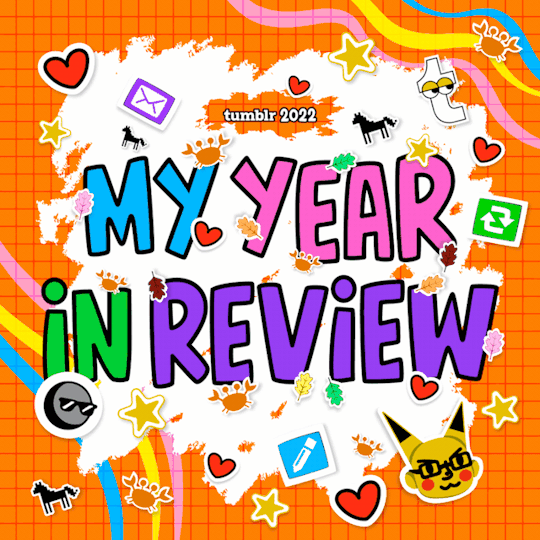
I posted 5,918 times in 2022
102 posts created (2%)
5,816 posts reblogged (98%)
Blogs I reblogged the most:
@gffa
@lightedwindows
@bedlamsbard
@blackestglass
@pearwaldorf
I tagged 5,917 of my posts in 2022
#star wars - 960 posts
#fanart - 520 posts
#get in my mouth - 477 posts
#fashion - 398 posts
#puppies - 373 posts
#obi-wan kenobi - 225 posts
#lotr - 184 posts
#meta - 161 posts
#yes this - 138 posts
#stranger things - 134 posts
Longest Tag: 68 characters
#jensen ackles: punching you in the face with handsomeness since 2000
My Top Posts in 2022:
#5
My niece had her baby very early this morning! I am officially a great aunt! Huzzah!
31 notes - Posted December 1, 2022
#4
A Myth of Devotion
by Louise Glück
When Hades decided he loved this girl
he built for her a duplicate of earth,
everything the same, down to the meadow,
but with a bed added.
Everything the same, including sunlight,
because it would be hard on a young girl
to go so quickly from bright light to utter darkness
Gradually, he thought, he'd introduce the night,
first as the shadows of fluttering leaves.
Then moon, then stars. Then no moon, no stars.
Let Persephone get used to it slowly.
In the end, he thought, she'd find it comforting.
A replica of earth
except there was love here.
Doesn't everyone want love?
He waited many years,
building a world, watching
Persephone in the meadow.
Persephone, a smeller, a taster.
If you have one appetite, he thought,
you have them all.
Doesn't everyone want to feel in the night
the beloved body, compass, polestar,
to hear the quiet breathing that says
I am alive, that means also
you are alive, because you hear me,
you are here with me. And when one turns,
the other turns—
That's what he felt, the lord of darkness,
looking at the world he had
constructed for Persephone. It never crossed his mind
that there'd be no more smelling here,
certainly no more eating.
Guilt? Terror? The fear of love?
These things he couldn't imagine;
no lover ever imagines them.
He dreams, he wonders what to call this place.
First he thinks: The New Hell. Then: The Garden.
In the end, he decides to name it
Persephone's Girlhood.
A soft light rising above the level meadow,
behind the bed. He takes her in his arms.
He wants to say I love you, nothing can hurt you
but he thinks
this is a lie, so he says in the end
you're dead, nothing can hurt you
which seems to him
a more promising beginning, more true.
34 notes - Posted April 15, 2022
#3

😍😍😍😍😍😍😍😍😍😍😍😍😍
102 notes - Posted February 7, 2022
#2
Every once in a while I remember how young Anakin was when he fell, and it blows my mind every time. That nightmare sitting on his throne in his lava castle is about 33 years old at the time of the Kenobi show. Just. What the actual fuck.
150 notes - Posted June 2, 2022
My #1 post of 2022
Don't Hesitate
by Mary Oliver
If you suddenly and unexpectedly feel joy,
don’t hesitate. Give in to it. There are plenty
of lives and whole towns destroyed or about
to be. We are not wise, and not very often
kind. And much can never be redeemed.
Still, life has some possibility left. Perhaps this
is its way of fighting back, that sometimes
something happens better than all the riches
or power in the world. It could be anything,
but very likely you notice it in the instant
when love begins. Anyway, that’s often the
case. Anyway, whatever it is, don’t be afraid
of its plenty. Joy is not made to be a crumb.
10,092 notes - Posted April 17, 2022
Get your Tumblr 2022 Year in Review →
#tumblr2022#year in review#my 2022 tumblr year in review#your tumblr year in review#all about me#random memes
3 notes
·
View notes
Text
9/22/23
Jessie's Boys
Morning Songs
Militia Says
She Was A Romanian
Gypsy
X-Boyfriend
Prison Shower Guard
Dorian
Thought She Was Ukrainian
Pete- Her Last Boyfriend
Trying To Plan A
Getaway
Make A Baby
Said She Was
Actually
American Romanian
Not A Gypsy
At All
LA
Golden Skinned
Blond
Just A Young 2nd Generation
34 Year Old
#FreeBritney
Trying To Be A Mom
Barred From Insulin
By Jealous exes
Like "Killing Of Mr. Green"
By Louis Duncan
Horrors
Crime "Ya"
Teen Mystery
Hell
"Lord Of The Rings"
Conspiracies
American Romanian
From LA
Discriminated Against
At Airbnb
And Idyllwild "Gay" Realty
By Jessie's Sothby's
Property Manager
Mary Schmitz
Who Couldn't Triangle
My Kids
After She Wrongfully Evicted
Me
And Scott
Couldn't Get
Me Jessie's Treehouse
Or Rescue Her
On His Motorcycle
Just Another Lady
Almost A
Mom
Smeared In Her Pretty
Prime
Like Marilyn
On Lies
Discriminated
Against By
Klu Klux Klan
Militia
Triangulated
Skinheads
Jealous Exes
Another Nazi "Mistake"
In A Long Line
Of Killings
Domino Effect
Addicts
Triangulating
Michael Thompson
Her "X" Boyfriend
Was There
When She Was Found
Gripping Keys- Stressed
Trying To Escape
Him
Taught Knuckles
Dead
Hands Clenched
Naked
In Bed
Was She "Barred"
From
Her Diabetic
Medicine
Insulin
Tortured To Death
Or Did She Die
On Fentanyl
Like Militia
Mitch
An Old Neighbor
Vanessa's Old Man
And Scott Clarke
Locals
Wanted You To Believe
Sheriff Jeremy Parson's
Proud Boys- Pine Cove
Enablers
Or Was It Staged By Gay
Trans-Moderators
From Florida
On Meta Facebook
Crime Watch
Social Media
Gossip
Post Apocalypse
Data Theft
A Play
Book
They
Want You To Believe
Collin
A Roomate
Was There
Reporting
Lies
Who Was He
Another Of Shane Stewart's
Impotent Latino Gay Lovers'
Addicts
Spying
Triangulating
Nazis
Jessie
Only
34 Years Old
Innocent
Before She Could
Bare
Her Babies
No obituary
Or Legacy
Pictures
To
Propagate Her
Soulmates
Prodigy
Just Pete
Possibly
Selling Her
Life
Who Was Collin
He Was There
Tabloid Columnists
Say Triangulated
In Affair
A Gay
Perhaps
Speculating
Who Was Collin
Did He Know Our
"Token" Black
Rastafarians
Blamed
Scapegoats
Sick
With Lymes
Who Was Collin
A Roommate
Planted
Did He Make Up
The One Liners
When He Got
Michael Thompson
Put Under
Forever
3 Months Later
Dead
Supposedly
Murdered
The Tree House
Pinecove Owners
Are Dead
But "Hurrah"
His Sons'
Might Have Said
Sarcastically
Dennis Glorified
Nymph-Happy-Endings
Prostrate Orgasms
Gluttony
All Forgotten
In "Pride"
Who Inherited
Homestead
Like When
Emily Pearson Died
A Property Manager
To Over 400 People
And Her Forgotten
Husband
Idy Folk
Wrongfully Evicted
In Covid
Rejected On
United Way 211
Silenced
Forgotten
Like When
Emily And Her
Husband Died
8 Hours Apart
No One Could Testify
What Really Happened
No Autopsy
Swept Under The Rug
Like So Many
Idyllwild Real Estate
Gay
Murders
For Shane Stewart's
Gangs
Swept Under The Rug
A "Hasbeen"
"Midnight In The"
Woods
Some Say
Scientologists
Took El Salvadorian
Wives
Daughters
Missing Persons
Victims
Alibis
For Megan's Law
Scares
At Lumber Mill
6 Other Restaurants
In Idy
Wanted To Write
About the "Garden
Of Good And Evil"
Like Savannah
Georgia
Writers
Eyes
We Got
Transvestites
Blooming
A Restaurant
Owner With
8 Pedophile
Charges
Louise Expected "Life"
Now Running Free
Yet Cops Come Running
For His Chef's
Humble
Car
Compounding
#CampCalifornia
Pimping Radar Out
And Golden Pitbull
Ryder
Pigs
Rape His Widow Friend
Liz
Charity Project
On Petty Crimes
For Addicts
Silencing Lies
Big "Stories" About
Shane Stewart's Lovers
Facts Omitted
8 Pedophile Crimes
Never Syndicated
News Stories
Butterfield's Brokers
12 Teachers At The Art Academy
Countless Students
Teachers Fired
Children Incarcerated
Silenced
Caged
Peace,
Nitya Nella Davigo Azam Moezzi Huntley Rawal
1 note
·
View note
Text
Meta Marie Louise featuring Max Usata & Sirup Gagavil @ Bad Bonn
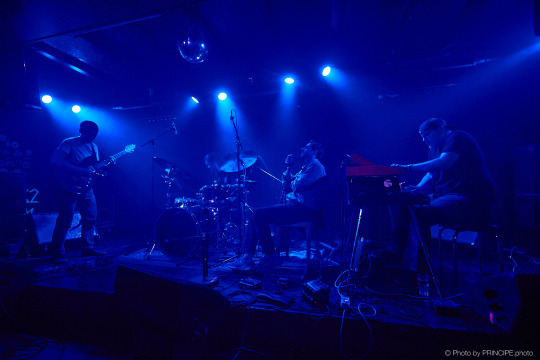
View On WordPress
0 notes
Text
someday I’m gonna write a long ass tvd meta post about siphons as an analogy for neurodivergency you just wait
#the vampire diaries#legacies#kai parker#malachai parker#valerie tulle#tvd malcom#nora hildegard#mary louise#tvd beau#tvd oscar#lizzie saltzman#josie saltzman#tvd meta#the vampire diaries meta#legacies meta
52 notes
·
View notes
Text
into the mirror cave
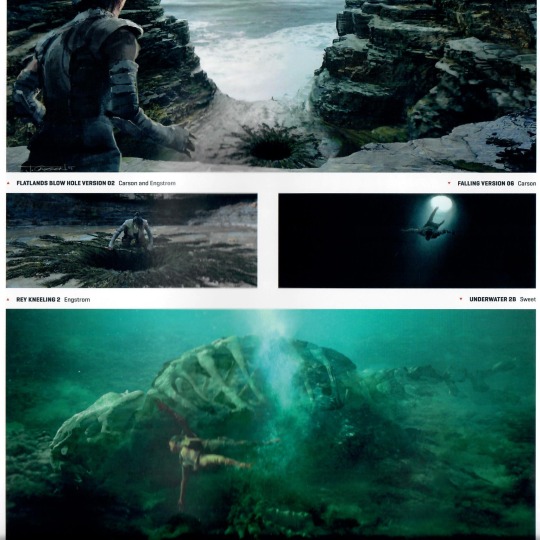

“The first thing I talked about with Rian was the mirror cave . . . What are Rey’s conflicts? This image reflects a little bit of the Kylo/Rey Force connections, as well as the duality of light and dark, good and evil. Some of these were being pulled from what I knew of The Force Awakens, but also little glints of information from Rian and mirroring the cave in Empire.” — James Clyne, VFX art director, The Art of Star Wars: The Last Jedi
“The idea is this island has incredible light and the first Jedi temple up top, and then it has an incredible darkness that’s balanced down underneath in the cave . . . In this search for identity, which is her whole thing, she finds all these various versions of ‘Who am I’ going off into infinity, all the possibilities of her. She comes to the end, looking for identity from somebody, looking for an answer, and it’s just her.” — Rian Johnson (x)
“The idea that if there’s a Jedi Temple up top, the light, it has to be balanced by a place of great darkness. We’re drawing a very obvious connection to Luke’s training and to Dagobah here, obviously. And so the idea was if the up top is the light, down underneath is the darkness. And she descends down into there and has to see, just like Luke did in the cave, her greatest fear. And her greatest fear is [that], in the search for identity, she has nobody but herself to rely on.” — Rian Johnson (x)
Some (long, rambling) thoughts on the mirror cave sequence below the cut.
Rian certainly took a page from the heroine’s journey and mined some Carl Jung here. In this post I’ll discuss the mirror cave and hut scenes and how they trace the “crossing the threshold” and “wedding the animus” steps. In a future post I’ll discuss Rey’s confrontation with Luke as the “confronting the powerless father [figure]” step.
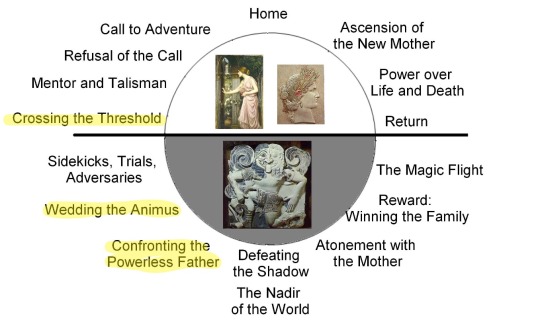
crossing the threshold: descent to “a dark place”
“There's something else beneath the island … A dark place.”
“You went straight to the dark.”
“That place was trying to show me something.”
For an excellent read on the heroine’s descent, see “The Descent: the Heroine’s Journey in The Force Awakens” and “Bride of the Monstrous: Meeting the Other in the Force Awakens” by @ashesforfoxes.
the heroine’s journey and the animus figure
A quick summary of some relevant Jungian concepts follows.
While the male hero goes on an active quest as a rite of passage (involving some physical feat like slaying the monster), the heroine goes on a more inward-focused quest (reconciling the monster within). The heroine’s journey involves an awakening within herself, by descending to a place where she can liberate her inner goddess.
In The Feminine in Fairy Tales, Jungian scholar Marie-Louise von Franz reminds us that this journey within is fundamental to the process of the heroine’s individuation, that it is “a time of initiation and incubation when a deep inner split is cured” by descending into the unconscious.
In The Heroine’s Journey, Maureen Murdock describes this descent as a “journey to our depths” that “invariably strengthens a woman and clarifies her sense of self” because it is a process of “looking for the lost pieces of myself” or seeking to complete oneself. As Murdock writes:
Persephone is pulled out of the innocence (unconsciousness) of everyday life into a deeper consciousness of self by Hades. She is initiated into the sexual mysteries … She becomes Queen of the Underworld.
Similarly, Rey is compelled to descend to that dark place underneath the island where she is pulled into a “deeper consciousness of self” mediated by her Force bond with Kylo. “That place was trying to show me something.” Note, “dark” here is not “evil” but it can show us something about ourselves (for instance, our greatest fears) as it represents the unconscious part of our psyche.
Persephone’s descent into the underworld is when she faces the unknown and matures. She had to leave her family and the familiar, namely the world above ruled by her mother Demeter in which she was kept in an infantile state of girlhood. The world below with Hades is where she accesses what Jungians call the animus and actualizes her selfhood as a woman.
So what is this animus? The anima and animus are “soul-image” archetypes projected onto a person typically of the opposite sex. The animus represents the masculine aspects of the female psyche. As von Franz tells us in The Feminine in Fairy Tales, the animus “has to do with ideas and concepts” and in fiction is typically represented by a man. In her essay “The Process of Individuation” in the Jung anthology Man and his Symbols, von Franz notes:
A vast number of myths and fairy tales tell of a prince, turned by witchcraft into a wild animal or monster, who is redeemed by the love of a girl—a process symbolizing the manner in which the animus becomes conscious. ... Very often the heroine is not allowed to ask questions about her mysterious, unknown lover and husband; or she meets him only in the dark and may never look at him. The implication is that, by blindly trusting and loving him, she will be able to redeem her bridegroom. But this never succeeds. She always breaks her promise and finally finds her lover again only after a long, difficult quest and much suffering.
The parallel in life is that the conscious attention a woman has to give to her animus problem takes much time and involves a lot of suffering. But if she realizes who and what her animus is and what he does to her, and if she faces these realities instead of allowing herself to be possessed, her animus can turn into an invaluable inner companion who endows her with the masculine qualities of initiative, courage, objectivity, and spiritual wisdom.
The animus, just like the anima, exhibits four stages of development. He first appears as a personification of mere physical power--for instance, as an athletic champion or “muscle man.” In the next stage he possesses initiative and the capacity for planned action. In the third phase, the animus becomes the “word,” often appearing as a professor or clergyman. Finally, in his fourth manifestation, the animus is the incarnation of meaning. On this highest level he becomes (like the anima) a mediator of the religious experience whereby life acquires new meaning. He gives the woman spiritual firmness, an invisible inner support that compensates for her outer softness. The animus in his most developed form sometimes connects the woman’s mind with the spiritual evolution of her age, and can thereby make her even more receptive than a man to new creative ideas. It is for this reason that in earlier times women were used by many nations as diviners and seers. The creative boldness of their positive animus at times expresses thoughts and ideas that stimulate men to new enterprises.
Fairy tales from the female individuation perspective are all about wedding the animus or reconciling with the monster, which is deeply identified with the heroine’s innermost self. This part of the journey is necessary to heal that inner psychic split, to become whole. Reconciling her animus in a positive way allows the heroine to access new ideas and concepts and achieve her creative potential. Rey must acknowledge and integrate her positive animus to “become what you were meant to be” (more on the positive vs negative animus below).
(Edit: See also this wonderful meta by @skysilencer elaborating on the anima and animus as parts of the psyche.)
rey’s mirror cave journey and kylo ren as her animus
Following the beats of the heroine’s journey and Jungian concepts, Rian has given us what many of us have predicted all along: Rey joining with Kylo Ren as her animus on her journey of self-discovery.
Rey descends through a black hole that pulls her into the ocean depths beneath the island. When she emerges at the mouth of the mirror cave, her hair is undone. This is the first step of her growth from girlhood to womanhood and the liberation of that inner goddess.
Rey kept her hair tightly coiled in those signature three buns all her life on Jakku because she clung to the infantile hope that her parents would return and recognize her. We now know that this hope was a fiction she fabricated to give herself a reason to live. We tell ourselves stories in order to live. Rey imposed her own rosy narrative on a harsh reality in order to survive. “Child . . . you already know the truth.” Indeed, as Maz correctly intuited, Rey already knew the truth: her parents were nobody and they were never going to come back for her.
Rey’s loosened hair represents letting go of that past and uncoiling that fictional narrative that was holding her back.
The new undone look also signifies a sexual awakening.
And who should be there, listening patiently, as a companion to Rey’s awakening? Rey narrates her mirror cave journey to none other than Kylo Ren, who is with her on that journey as her animus.
Recall, the animus first appears as “mere physical power” but in a higher form gives the woman “an invisible inner support” as mediator of a meaningful spiritual experience. At first, Kylo appeared to Rey as a creature in a mask, a manifestation of mere physical power. Through their Force bond, Kylo certainly manifests as a “muscle man” particularly when he refuses to throw on something to cover those gleaming pecs. Later, he becomes a source of spiritual support when he assures Rey “you’re not alone” after she confides to him she had never felt so alone as in that cave where she sought answers.
Also, recall, the animus has to do with ideas and concepts. Kylo represents the idea of “let the past die” on Rey’s path to self-actualization. Rey needs to hear this in order to move on from her disappointment at being so casually tossed aside by her parents. While Rey clings to the past (her parents, Luke the legend who she says the galaxy needs, the myth of the Jedi and the Jedi “page-turners” she takes on the Falcon), Kylo wants to throw it all away. Kylo wants to tear down the curtains, just as those red velvet curtains in Snoke’s throne room burned away to reveal the black void of space around them. Kylo wants to live in that black void of cold reality where Luke and the Jedi are demythologized and deconstructed, where he can see clearly Rey’s parents for who they were as opposed to the childish way Rey put a curtain over the truth with her own make-believe tale (“they’ll be back … one day”). Rey needs a cold splash of that demythologization to grow up.
As Rian Johnson tells us in The Art of Star Wars: The Last Jedi, there’s “a sin in venerating the past so much that you’re enslaved to it.” Yet the idea is not so simple, as Rian also acknowledges the need to reconnect with the past (and implicitly the need to re-construct myths by which to live):
If you think you are throwing away the past, you are fooling yourself. The only way to go forward is to embrace the past, figure out what is good and what is not good about it. But it’s never going to not be a part of who we all are.
We become “enslaved” if we go too far in either direction, whether venerating the past too much or wanting so badly to desecrate and “kill” the past. The extreme and destructive way in which Kylo seeks to “kill it” represents the negative animus. That side is, paradoxically, too emotionally tied to the past (and fixated on perceived past wrongs), unwilling to simply let go of the anger and resentment. To integrate her positive animus, Rey needs to acknowledge and learn from the past by looking at it in an objective way, which requires distancing herself instead of letting the past rule her emotions. Both Rey and Kylo need to embrace the past and the fact that it is part of who they are, in order to move forward.
Let’s distinguish the positive animus from the negative animus, which can be identified with the heroine’s shadow. The negative animus often appears as a sort of “death-demon” or murderer (“murderous snake” for instance) and “personifies all those semiconscious, cold, destructive reflections that invade a woman in the small hours” according to von Franz. Bluebeard would be an example of the negative animus: a seducer who is ultimately destructive and must be overcome. The negative animus can be that inner critic reinforcing feelings of worthlessness.
In what ways is Kylo a negative or positive animus?
Negative animus: Kylo who embraces the monster role (“Yes, I am”). Kylo who says “you have no place in this story . . . you’re nothing” and resents the past. Kylo who is filled with so much self-loathing he stabs in the heart the man whose heart he has too much of (“You have too much of your father's heart in you, young Solo”) and wants to blast out of the sky the “piece of junk” in which he was conceived. Kylo who rages against the galaxy, who wants to impose a new order on the galaxy.
Positive animus: Kylo who says, “But not to me. Join me. Please.” Kylo who responds to “Ben” and who Rey sees turning in the future (“If I go to him, Ben Solo will turn”). Kylo who desperately needs to make peace with the past. Kylo who tells Rey, “You’re not alone.” Kylo who fought side by side with Rey, perfectly in sync. Kylo who we are rooting for to ultimately make peace with the galaxy.
Kylo has the potential to be Rey’s positive animus, but at the end of the film she cannot reconcile with him yet because he has not yet transformed from the murderous negative animus to Rey’s positive animus.
rey’s search for identity
“Who are you? … What’s special about you?”
Here, I digress a bit to discuss why Rey “nobody” is the perfect reveal and try to address some of the criticisms about the jarring sequence in the cave.
First, the way this sequence is filmed and narrated is superbly meta. Just as Rey is pulled out of her “everyday life” into another realm of consciousness, so are we as the audience pulled out of the immersive experience of the breakneck-paced dramatic narrative into a more self-reflective space. Some have criticized this moment as violating that rule of immersion, breaking the fourth wall and taking us out of the film. Reminiscent of Yayoi Kusama’s popular Infinity Mirrors exhibit, Rey’s mirror cave scenes evoke the experience of being in a modern art installation. You are part of those infinite possibilities. It is you, the audience, who create those infinite selves. This is entirely intentional and I believe indicative of Rian Johnson’s brand of auteurism: entirely self-aware and humbly transparent about his intentions. We are meant to reflect on our own assumptions about Rey. We are meant to question, does it really matter who her parents are? Why do we think it matters? For the fans who wanted her to be blood-related to a legacy Star Wars character: what does that say about you and your view of a character’s worth? your view of what builds character?
In The Art of Star Wars: The Last Jedi, Rian explains that he wanted to explore, “What do you keep from the past and what do you not? What is the value of the myths you grew up with? What is the value of throwing those away and doing something new and fresh?” In a very meta way, his treatment of Rey’s struggle with her past in The Last Jedi also led the fandom to question: What is the value of the mystery box?
So much criticism has been leveled about the “empty mystery box” and how anti-climactic it is to show us Rey’s own reflection at the end of the corridor of infinite selves after teasing us with those murky shadows behind the glass, as if mocking fans for their intense speculative interest in her parentage, which was arguably one of JJ’s deliberately constructed mystery boxes.
Did Rian totally deconstruct and wreck that box? Well, not exactly, because the point of the mystery box was never to yield a white rabbit like a simple magic track. From JJ’s TED talk:
The thing is that it represents infinite possibility. It represents hope. It represents potential. And what I love about this box, and what I realize I sort of do in whatever it is that I do, is I find myself drawn to infinite possibility, that sense of potential. And I realize that mystery is the catalyst for imagination. Now, it's not the most ground-breaking idea, but when I started to think that maybe there are times when mystery is more important than knowledge.
The mirror cave itself is a representation of the mystery box and Rey’s infinite potential. Rian, in a sense, preserves that mystery, that infinite possibility.
JJ goes on in his TED talk:
And then, finally, there's … the idea of the mystery box. Meaning, what you think you're getting, then what you're really getting. And it's true in so many movies and stories. Look at "E.T.," for example — “E.T." is this unbelievable movie about what? It's about an alien who meets a kid, right? Well, it's not. "E.T." is about divorce. "E.T." is about a heartbroken, divorce-crippled family, and ultimately, this kid who can't find his way … When you look at a movie like "Jaws," the scene that you expect … she's being eaten; there's a shark …The thing about "Jaws" is, it's really about a guy who is sort of dealing with his place in the world — with his masculinity, with his family, how he's going to, you know, make it work in this new town.
So many thought Rey was Luke 2.0 and that this story was about her going from nobody to somebody by virtue of discovering she belongs to an elite bloodline. So many thought The Last Jedi would be about passing the torch to the next Jedi. Well, it’s not really about the next Skywalker or the next Jedi. This story is about a girl finding her place in the world, who can’t find her way because she kept telling herself a lie about her past that trapped herself in her own mystery box, a box of her own making that allowed her to live with hope and at the same time limited her growth and kept her all alone. She told herself “they’ll be back … one day” when she knew her parents were never coming back. This story is about a girl who feels so alone. She meets a boy who feels this too: “You’re so lonely.” When Rey and Kylo are Force bonding together, their scenes are marked by silence, stripped bare of the noise and the sturm und drang of an epic-scale John Williams score, stripped down to the intimate-scale essence of their story: “You’re not alone.” “Neither are you.”
What Rian gives us is what we were really going to get all along: the revelation that the real substance is not in the box’s contents (the answer to the mystery of Rey’s parentage) but in that negative space around the mystery box, which is about two kids dealing with their loneliness.
So what do we make of Rey gazing at her own reflection, disappointed and alone?
Some have criticized the mirror cave sequence as an indulgent interlude emblematic of the vanity endemic to today’s narcissistic navel-gazing “me” generation—both the vanity of the auteur as well as the vanity of the film’s populist self-empowerment message. The mirror cave with its echo chamber and mirrors do bring to mind Echo and Narcissus. When Rey snaps her fingers, she hears nothing but her own sound, infinitely echoed. When Rey looks into the mirrors, she sees nothing but herself, infinitely reflected. (Edit: To be clear, I’m not agreeing with the “me” generation assessment. Also, it’s true that there are covert narcissists who feel vulnerable and neglected and that a deep-seated sense of insecurity or lack of self-esteem is at the root of narcissism. Rey and Kylo both exhibit some of this insecurity.)
Yet Rey is the opposite of a Narcissus. She doesn’t worship her own image or hold a grandiose view of herself (or lack empathy for others for that matter). Rather, she must learn to love herself instead of seeking love and validation from stand-in parental figures. As Kylo says, “Your parents threw you away like garbage. But you can’t stop needing them. It’s your greatest weakness. Looking for them everywhere, in Han Solo, now in Skywalker.” Here, unlike Narcissus who needed to detach himself from excessive love for his own image, Rey must come to embrace herself as worthy and self-sufficient. (Edit: Also, here, Rey is horrified rather than delighted to see her own reflections. See also Reyflections of Existential Horror from @and-then-bam-cassiopeia.)
As Rian tells us, her greatest fear is that she has nobody but herself to rely on. She must face that fear head on and realize she is enough, that all she needs is right in front of her nose (as Yoda might say).
She also comes to realize: “You’re not alone.”
wedding the animus: “when we touched hands”
“I thought I’d find answers here. I was wrong.” Yet the mirror cave does show Rey something vital to her search for identity: her own duality. At the end of that seemingly infinite hall of mirrors, Rey sees two shadowy figures walking forward behind the glass who then merge into one to form her own reflection. The shadows evoke a masculine figure and a feminine figure.
The “Kylo Kira Force Mash” concept art and its placement together with the mirror cave concept art on the same page in The Art of Star Wars: The Last Jedi suggest to me that the two shadows merging into one and emerging as Rey’s reflection is supposed to represent both (1) the duality of masculine and feminine within each of us, in particular Kylo and Rey wedding into one as Rey assimilates Kylo as her animus, and (2) the duality of light and dark within each of us.
Recall, the idea of wedding the animus is that we need to reconcile and integrate both sides (both masculine and feminine, both light and dark) to become whole.
The mirror cave scenes are followed by a “wedding the animus” scene. After Rey narrates her mirror cave journey to Kylo, sitting with him in the hut through their Force bond, she proceeds to engage in perhaps the most intimate act we have ever seen in Star Wars (or Disney for that matter). She extends her hand, and the camera zooms obscenely close to Rey and Kylo’s bare fingers making contact.
In this moment, as she gasps, she sees a future with Ben. She sees him turning against Snoke. (Yes, he does turn against Snoke, but her vision is incomplete as he doesn’t turn against the First Order yet.) Likewise, he sees a future with her: “When the moment comes, you’ll be the one to turn. You’ll stand with me.” (I do think that in Episode IX we will see Rey standing with Kylo and turning to help him in some way, but Kylo’s vision is also incomplete in that she rejects his plea to join him in the throne room and does not turn against the Resistance.)
Yes, this moment is more intimate than a simple kiss or other physical act of intimacy, because Rey and Kylo are envisioning future lives together, standing side by side. Wedded to each other by the Force. The Force theme begins to play at this moment, as if underscoring the divine inevitability of this union.
Why does Rey fail to see clearly that Kylo would not yet turn in the throne room? “Ben, when we touched hands, I saw your future. Just the shape of it, but solid and clear.” Here I’m reminded of those shadowy figures again, and these verses from Corinthians 13:11 and 13:12 much referenced in literature and film:
When I was a child, I spake as a child, I understood as a child, I thought as a child: but when I became a man, I put away childish things.
For now we see through a glass, darkly; but then face to face: now I know in part; but then shall I know even as also I am known.
Rey is somewhat naive, like a child. In the mirror cave when she touches the glassy surface and in the hut when she touches Kylo’s hand, she sees through a glass, darkly. Rey’s knowledge of herself and her past is imperfect. Rey’s knowledge of Ben and the future is imperfect. Her vision is obscured by her naiveté and hope, by her optimistic insistence on clinging to rose-colored glasses and red curtains.
Chapter 13 in Corinthians is about love (sometimes translated to charity). What is a theme throughout Star Wars? Compassion. As Joseph Campbell points out, this means to suffer together, to feel someone else’s suffering as our own and wish to relieve that suffering.
Kylo began to feel compassion for Rey in the interrogation room when he discovered her loneliness. “You’re not alone.” Her suffering at Snoke’s hands likely contributed to his resolve to conceal his true thoughts from his master and slay Snoke at the right moment. When Rey is cut on the shoulder by a Praetorian Guard, Kylo glances towards her anxiously, further evidencing his compassion for her. However, he lacks compassion for her concern with her friends and the plight of the Resistance. He is still thinking in terms of “you’ll stand with me” instead of “we will stand together” working towards a shared goal.
Rey begins to feel compassion for Ben Solo through their Force bond, when she sees that fateful temple-burning night from Kylo’s point of view and learns that Luke lied about how he behaved. She also feels Ben’s loneliness. “Neither are you.” She extends her hand out of compassion. However, she didn’t ship herself to the Supremacy for Ben Solo, she went there to save her friends, and he understands that when she turns to the window port and demands, “Order them to stop firing!” Recall Rey’s reasons to Luke before flying off on the Falcon:
If he were turned from the dark side, that could shift the tide. This could be how we win.
Rey too is thinking about her own agenda, as opposed to what Kylo wants to accomplish: “We can rule together and bring a new order to the galaxy.” Kylo’s proposal to Rey, which involved a future together, is met with what he might have perceived to be an attempt on his life, though Rey’s grab for the lightsaber might simply have been her way of sending the message: you are not worthy of this yet. Neither of them are truly able to see from each other’s point of view; each has more to grow to reach that common ground and to truly love and suffer together.
At the end of the film, Kylo remains a negative animus who has not yet fully processed and embraced the past as part of who he is, full of murderous rage (“blow that piece of junk out of the sky!” and “more! more!”). His rage masks his true misery and self-loathing, which is pitifully obvious from the way he looks at Rey through their Force bond at the very end of the film, then slowly closes his fingers around the projected gold dice as he realizes despite his ascension to Supreme Leader he truly holds on to nothing. He's not angry and resentful in that moment. He's heartbroken and sad.
But … Ben Solo will turn. The structure of the heroine’s journey mandates that Rey will somehow reconcile with her positive animus.
#tlj spoilers#mirror cave#the art of star wars: the last jedi#my scans#tlj meta#carl jung#marie-louise von franz#heroine's journey#heroine's descent#rey x kylo ren#kylo ren as animus#negative animus#positive animus#wedding the animus#tlj art book#my meta
2K notes
·
View notes
Text
Why I hate the Lying Detective
It is a unanimous opinion that the Lying Detective is the best episode of the weak fourth series. Some even believe it is one of the best Sherlock episodes overall. I bet those people are the ones who watch Sherlock for the cases, for being a crime show, meaning for being something other than what it is. TLD has indeed one of the most memorable villains, definitely the most repulsive one. However, in my opinion the good villain isn't enough to save this otherwise horrendous episode.
Sherlock is beyond stupid and beyond intelligent simultaneously
Throughout the whole episode, it is revealed that despite being so deep in the drugs, Sherlock still is intelligent enough to predict the future. Apparently, he is so intelligent that John's actions (including the physical abuse that hospitalized him? I wonder) come as natural and perfectly expected to him. However, he is not intelligent enough to tell that the woman two feet apart from him is not the same woman he stares at in a photo.
There are ridiculous comic reliefs
If you want to go full dark, either go all the way or go home. The episode is full of epidermic comedic scenes that serve absolutely no purpose except to destroy the characterization a little more. One example is Mrs Hudson smobbin that Aston Martin, for literally no reason. And whatever she says, an Aston Martin can not be explained by the rest of the living we see her lead. It would be nice if Moftiss could understand what woman empowerment actually means - and it is not that. Mrs Hudson has been evolving from a motherly yet strong and fun character to a caricature.
Awkward secondary characters
I don't know if they all felt awkward in this episode but either the secondary characters are forced in this one or the acting is mediocre at best. Molly Hooper is written so strangely in this episode, you can see Louise Brealey not knowing what to do with her character. Quick fake depth is attempted with disastrous results, like when Mrs Hudson calls Mycroft a reptile for no reason whatsoever, even though it's established in TEH that she can tell Mycroft loves and cares about Sherlock.
Wasting precious time
Whereas they could use time to give some more rigid presence to the secondary characters or deepen the interaction between Sherlock and John (and the workings of their minds and hearts), the time is wasted in stretched deductions (i.e with Faith!Eurus and that bloody window) or torturous ghost!Mary scenes.
Mary loves being here
Mary really loved it. Amanda probably did too. Nobody else did, I am afraid. You think by the end of TST, that the dynamic between Sherlock and John will be restored, yet an enormous Mary phantom emerges (John's initiative) to fuck things up even more than before. By being John's secret self, Mary finally fully becomes a John Watson in the place of John Watson, leaving the actual one to be an undefineable mass of bones and fury. But as if this wasn't enough, we don't have one but TWO Marys. The other one is the real one who clearly refuses to die by saving her legacy in a thousand DVDs. There we are reminded that Sherlock Holmes and John Watson can not work out their relationship on their own and they need the deceased amoral yet somehow perfect wife to show them the way. Which is a very amoral way, unsurprisingly.
John who?
Is there any reason why in this episode nobody recognizes John? This was never a thing prior to this episode. If this was an attempt at symbolic meta-narrative (John has become unrecognizable), Moffat failed miserably. At face value, it cannot be explained why nobody seems to know who John Watson is, even though they all visit his blog. Also, the very-good-army-doctor now wouldn't be able to treat your flu. Even Sherlock realises John acts like he has never stepped a foot on Medicine School in the end. But what was the point of this? Is this meta-criticism? Like, we are going to destroy John's character and then ridicule the destroyed version on our own??? Beats me.
John WHO
John is really unrecognizeable, no shit Sherlock. Please remember that we have seen John being sullen, angry and hurt before (ASIP, TEH, HLV). The TLD John is somebody else. I don't have a problem with him being even angrier or even darker or more aggressive but the problem is that he is an entirely different character, belonging to an entirely different show that has nothing to do with the Sherlock Holmes universe. We have also seen John hitting Sherlock before (ASIB, TEH) and he is lowkey always done with him but THIS.IS.SOMEBODY.ELSE. TLD John enters the room and I can feel cold goosebumps down my spine. He is a walking fridge next to a Sherlock that can't see straight. What mockery is this. He is the most unpleasant thing to watch in an overall unpleasant episode and the mortuary scene is downright unwatchable, because we can trace back his actions on so many things (read my analysis John's choices if you are interested) but a) the moral rock is suddenly nowhere to be seen, b) he has no control or self-restraint in his attack, c) THERE IS NO REAL REGRET. There is no regret except an acknowledgement (which is not the same thing as regret) to Lestrade that he hit Sherlock "real hard", all the while the camera focuses on his bloody knuckles. This is an offense to the Holmes and Watson legacy. The regret continues to be loudly absent when next thing we see, John attempts to end his frienship with Sherlock, chooses to trust Culverton more than Sherlock, his rescue of Sherlock is way too lukewarm, he never apologises and he remains frigid during and after the reconciliation and well up to the end of the Final Problem. Anyone of them care to explain why the official ending of the show leaves the two in their absolute worst with each other??? And of course, throughout the last episodes, all their choices are pre-decided by Mary, the apparently real lead character, as they no more have brains and hearts of their own. It's a good thing we are subtextually told that John still wants to fuck Sherlock in the hat. This makes me feel soooo much better. The only thing left for me to wonder is how much responsibility in this belongs to Moftiss and / or Martin Freeman and / or Amanda Abbington. This is only a speculation of course but if you are interested in this read Freebatch: Could it be that it affected the future of Sherlock?
#bbc sherlock#sherlock#johnlock#sherlock holmes#john watson#s4e2#series 4#negativity#s4 wank#freebatch#tld#the lying detective#review
96 notes
·
View notes
Photo
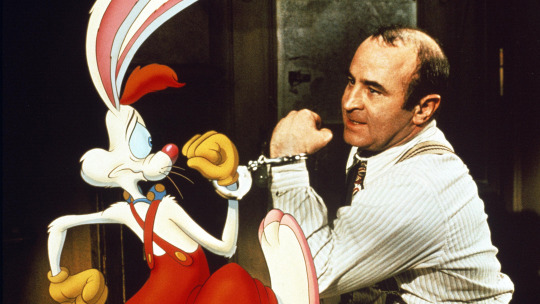
Blurring the Line.
As a new Space Jam film beams down to Earth, Kambole Campbell argues that a commitment to silliness and a sincere love for the medium is what it takes to make a great live-action/animation hybrid.
The live-action and animation hybrid movie is something of a dicey prospect. It’s tricky to create believable interaction between what’s real and what’s drawn, puppeteered or rendered—and blending the live and the animated has so far resulted in wild swings in quality. It is a highly specific and technically demanding niche, one with only a select few major hits, though plenty of cult oddities. So what makes a good live-action/animation hybrid?
To borrow words from Hayao Miyazaki, “live action is becoming part of that whole soup called animation”. Characters distinct from the humans they interact with, but rendered as though they were real creatures (or ghosts), are everywhere lately; in Paddington, in Scooby Doo, in David Lowery’s (wonderful) update of Pete’s Dragon.
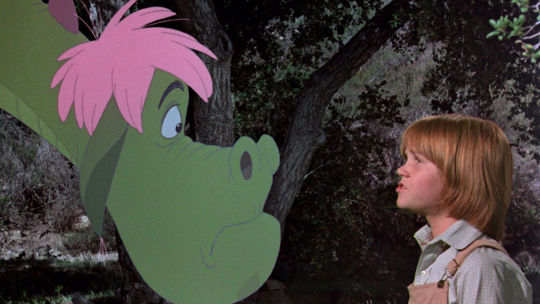
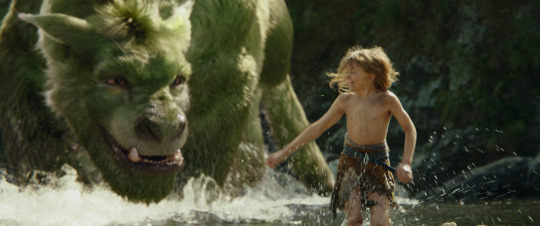
The original ‘Pete’s Dragon’ (1977) alongside the 2016 remake.
Lowery’s dragon is realized with highly realistic lighting and visual-effects work. By comparison, the cartoon-like characters in the 1977 Pete’s Dragon—along with other films listed in Louise’s handy compendium of Disney’s live-action animation—are far more exaggerated. That said, there’s still the occasional holdout for the classical version of these crossovers: this year’s Tom and Jerry replicating the look of 2D through 3D/CGI animation, specifically harkens back to the shorts of the 1940s and ’50s.
One type of live-action/animation hybrid focuses on seamless immersion, the other is interested in exploring the seams themselves. Elf (2003) uses the aberration of stop-motion animals to represent the eponymous character as a fish out of water. Ninjababy, a Letterboxd favorite from this year’s SXSW Festival, employs an animated doodle as a representation of the protagonist’s state of mind while she processes her unplanned pregnancy.
Meanwhile, every Muppets film ever literally tears at the seams until we’re in stitches, but, for the sake of simplicity, puppets are not invited to this particular party. What we are concerned with here is the overlap between hand-drawn animation and live-action scenes (with honorable mentions of equally valid stop-motion work), and the ways in which these hybrids have moved from whimsical confections to nod-and-wink blockbusters across a century of cinema.

Betty Boop and Koko the clown in a 1938 instalment of the Fleischer brothers’ ‘Out of the Inkwell’ series.
Early crossovers often involve animators playing with their characters, in scenarios such as the inventive Out of the Inkwell series of shorts from Rotoscope inventor Max Fleischer and his director brother Dave. Things get even more interactive mid-century, when Gene Kelly holds hands with Jerry Mouse in Anchors Aweigh.
The 1960s and ’70s deliver ever more delightful family fare involving human actors entering cartoon worlds, notably in the Robert Stevenson-directed Mary Poppins and Bedknobs and Broomsticks, and Chuck Jones’ puntastic The Phantom Tollbooth.

Jerry and Gene dance off their worries in ‘Anchors Aweigh’ (1945).
Mary Poppins is one of the highest-rated live-action/animation hybrids on Letterboxd for good reason. Its sense of control in how it engages with its animated creations makes it—still!—an incredibly engaging watch. It is simply far less evil than the singin’, dancin’ glorification of slavery in Disney’s Song of the South (1946), and far more engaging than Victory Through Air Power (1943), a war-propaganda film about the benefits of long-range bombing in the fight against Hitler. The studio’s The Reluctant Dragon (1941) also serves a propagandistic function, as a behind-the-scenes studio tour made when the studio’s animators were striking.
By comparison, Mary Poppins’ excursions into the painted world—replicated in Rob Marshall’s belated, underrated 2018 sequel, Mary Poppins Returns—are full of magical whimsicality. “Films have added the gimmick of making animation and live characters interact countless times, but paradoxically none as pristine-looking as this creation,” writes Edgar in this review. “This is a visual landmark, a watershed… the effect of making everything float magically, to the detail of when a drawing should appear in front or the back of [Dick] Van Dyke is a creation beyond my comprehension.” (For Van Dyke, who played dual roles as Bert and Mr Dawes Senior, the experience sparked a lifelong love of animation and visual effects.)
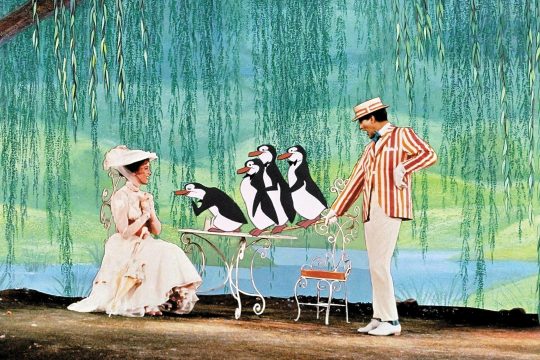
Julie Andrews, Dick Van Dyke and penguins, in ‘Mary Poppins’ (1964).
Generally speaking, and the Mary Poppins sequel aside, more contemporary efforts seek to subvert this feeling of harmony and control, instead embracing the chaos of two worlds colliding, the cartoons there to shock rather than sing. Henry Selick’s frequently nightmarish James and the Giant Peach (1996) leans into this crossover as something uncanny and macabre by combining live action with stop motion, as its young protagonist eats his way into another world, meeting mechanical sharks and man-eating rhinos. Sally Jane Black describes it as “riding the Burton-esque wave of mid-’90s mall goth trends and blending with the differently demonic Dahl story”.
Science-classroom staple Osmosis Jones (2001) finds that within the human body, the internal organs serve as cities full of drawn white-blood-cell cops. The late Stephen Hillenburg’s The Spongebob Squarepants Movie (2004) turns its real-life humans into living cartoons themselves, particularly in a bonkers sequence featuring David Hasselhoff basically turning into a speedboat.

David Hasselhoff picks up speed in ‘The Spongebob Squarepants Movie’ (2004).
The absurdity behind the collision of the drawn and the real is never better embodied than in another of our highest-rated live/animated hybrids. Released in 1988, Robert Zemeckis’ Who Framed Roger Rabbit shows off a deep understanding—narratively and aesthetically—of the material that it’s parodying, seeking out the impeccable craftsmanship of legends such as director of animation Richard Williams (1993’s The Thief and the Cobbler), and his close collaborator Roy Naisbitt. The forced perspectives of Naisbitt’s mind-bending layouts provide much of the rocket fuel driving the film’s madcap cartoon opening.
Distributed by Walt Disney Pictures, Roger Rabbit utilizes the Disney stable of characters as well as the Looney Tunes cast to harken back to America’s golden age of animation. It continues a familiar scenario where the ’toons themselves are autonomous actors (as also seen in Friz Freleng’s 1940 short You Ought to Be in Pictures, in which Daffy Duck convinces Porky Pig to try his acting luck in the big studios).

Daffy Duck plots his rise up the acting ranks in ‘You Ought to Be in Pictures’ (1940).
Through this conceit, Zemeckis is able to celebrate the craft of animation, while pastiching both Chinatown, the noir genre, and the mercenary nature of the film industry (“the best part is… they work for peanuts!” a studio exec says of the cast of Fantasia). As Eddie Valiant, Bob Hoskins’ skepticism and disdain towards “toons” is a giant parody of Disney’s more traditional approach to matching humans and drawings.
Adult audiences are catered for with plenty of euphemistic humor and in-jokes about the history of the medium. It’s both hilarious (“they… dropped a piano on him,” one character solemnly notes of his son) and just the beginning of Hollywood toying with feature-length stories in which people co-exist with cartoons, rather than dipping in and out of fantasy sequences. It’s not just about how the cartoons appear on the screen, but how the human world reacts to them, and Zemeckis gets a lot of mileage out of applying ’toon lunacy to our world.
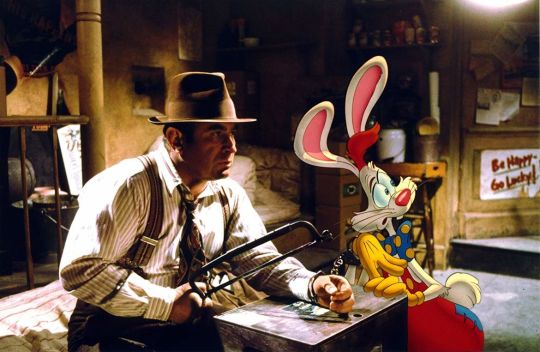
Bob Hoskins in ‘Who Framed Roger Rabbit?’ (1988).
The groundbreaking optical effects and compositing are excellent (and Hoskins’ amazing performance should also be credited for holding all of it together), but what makes Roger Rabbit such a hit is that sense of controlled chaos and a clever tonal weaving of violence and noirish seediness (“I’m not bad… I’m just drawn that way”) through the cartoony feel. And it is simply very, very funny.
It could be said that, with Roger Rabbit, Zemeckis unlocked the formula for how to modernize the live-action and animation hybrid, by leaning into a winking parody of what came before. It worked so perfectly well that it helped kickstart the ‘Disney renaissance' era of animation. Roger Rabbit has influenced every well-known live-action/animation hybrid produced since, proving that there is success and fun to be had by completely upending Mary Poppins-esque quirks. Even Disney’s delightful 2007 rom-com Enchanted makes comedy out of the idea of cartoons crossing that boundary.
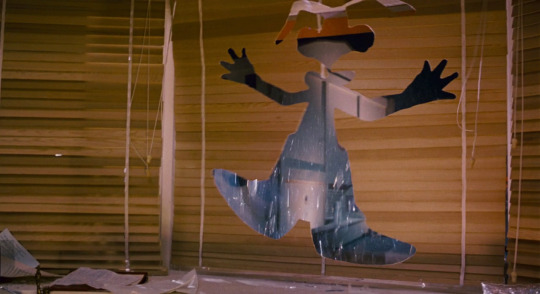
When a cartoon character meets real-world obstacles.
Even when done well, though, hybrids are not an automatic hit. Sitting at a 2.8-star average, Joe Dante’s stealthily great Looney Tunes: Back in Action (2003) is considered by the righteous to be the superior live-action/animated Looney Tunes hybrid, harkening back to the world of Chuck Jones and Frank Tashlin. SilentDawn states that the film deserves the nostalgic reverence reserved for Space Jam: “From gag to gag, set piece to set piece, Back in Action is utterly bonkers in its logic-free plotting and the constant manipulation of busy frames.”
With its Tinseltown parody, Back in Action pulls from the same bag of tricks as Roger Rabbit; here, the Looney Tunes characters are famous, self-entitled actors. Dante cranks the meta comedy up to eleven, opening the film with Matthew Lillard being accosted by Shaggy for his performance in the aforementioned Scooby Doo movie (and early on throwing in backhanded jokes about the practice of films like itself as one character yells, “I was brought in to leverage your synergy!”).
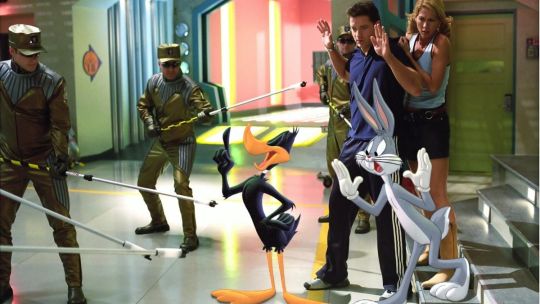
Daffy Duck with more non-stop banter in ‘Looney Tunes: Back in Action’ (2003).
Back in Action is even more technically complex than Roger Rabbit, seamlessly bringing Looney Tunes physics and visual language into the real world. Don’t forget that Dante had been here before, when he had Anthony banish Ethel into a cartoon-populated television show in his segment of Twilight Zone: The Movie. Another key to this seamlessness is star Brendan Fraser, at the height of his powers here as “Brendan Fraser’s stunt double”.
Like Hoskins before him, Fraser brings a wholehearted commitment to playing the fed-up straight man amidst cartoon zaniness. Fraser also brought that dedication to Henry Selick's Monkeybone (2001), a Roger Rabbit-inspired sex comedy that deploys a combo of stop-motion animation and live acting in a premise amusingly close to that of 1992’s Cool World (but more on that cult anomaly shortly). A commercial flop, Back in Action was the last cinematic outing for the Looney Tunes for some time.
Nowadays, when we think of live-action animation, it’s hard not to jump straight to an image of Michael Jordan’s arm stretching to do a half-court dunk to save the Looney Tunes from slavery. There’s not a lot that can be fully rationalized about the 1996 box-office smash, Space Jam. It is a bewildering cartoon advert for Michael Jordan’s baseball career, dreamed up off the back of his basketball retirement, while also mashing together different American icons. Never forget that the soundtrack—one that, according to Benjamin, “makes you have to throw ass”—includes a song with B-Real, Coolio, Method Man and LL Cool J.
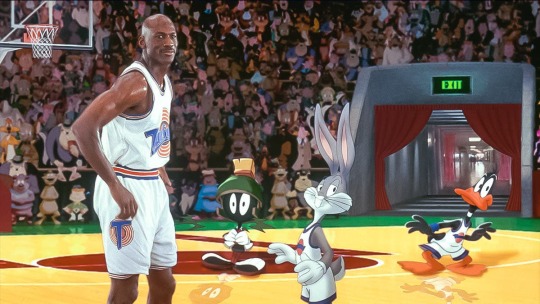
Michael Jordan and teammates in ‘Space Jam’ (1996).
Space Jam is a film inherently born to sell something, predicated on the existing success of a Nike commercial rather than any obvious passion for experimentation. But its pure strangeness, a growing nostalgia for the nineties, and meticulous compositing work from visual-effects supervisor Ed Jones and the film’s animation team (a number of whom also worked on both Roger Rabbit and Back in Action), have all kept it in the cultural memory.
The films is backwards, writes Jesse, in that it wants to distance itself from the very cartoons it leverages: “This really almost feels like a follow-up to Looney Tunes: Back in Action, rather than a predecessor, because it feels like someone watched the later movie, decided these Looney Tunes characters were a problem, and asked someone to make sure they were as secondary as possible.” That attempt to place all the agency in Jordan’s hands was a point of contention for Chuck Jones, the legendary Warner Bros cartoonist. He hated the film, stating that Bugs would never ask for help and would have dealt with the aliens in seven minutes.
Space Jam has its moments, however. Guy proclaims “there is nothing that Deadpool as a character will ever have to offer that isn’t done infinitely better by a good Bugs Bunny bit”. For some, its problems are a bit more straightforward, for others it’s a matter of safety in sport. But the overriding sentiments surrounding the film point to a sort of morbid fascination with the brazenness of its concept.

Holli Would (voiced by Kim Basinger) and Frank Harris (Brad Pitt) blur the lines in ‘Cool World’ (1992).
Existing in the same demented… space… as Space Jam, Paramount Pictures bought the idea for Cool World from Ralph Bakshi as it sought to have its own Roger Rabbit. While Brad Pitt described it as “Roger Rabbit on acid” ahead of release, Cool World itself looks like a nightmare version of Toontown. The film was universally panned at the time, caught awkwardly between being far too adult for children but too lacking in any real substance for adults (there’s something of a connective thread between Jessica Rabbit, Lola Bunny and Holli Would).
Ralph Bakshi’s risqué and calamitously horny formal experiment builds on the animator’s fascination with the relationship between the medium and the human body. Of course, he would go from the immensely detailed rotoscoping of Fire and Ice (1983) to clashing hand-drawn characters with real ones, something he had already touched upon in the seventies with Heavy Traffic and Coonskin, whose animated characters were drawn into real locations. But no one besides Bakshi quite knew what to do with the perverse concept of Brad Pitt as a noir detective trying to stop Gabriel Byrne’s cartoonist from having sex with a character that he drew—an animated Kim Basinger.
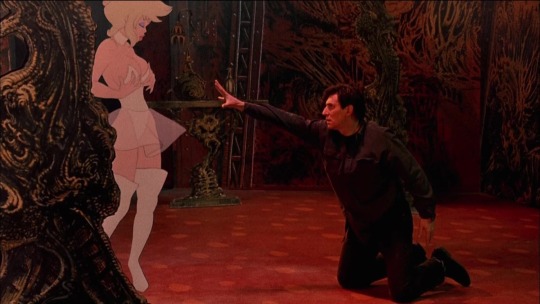
Jack Deebs (Gabriel Byrne) attempts to cross over to Hollie Would in ‘Cool World’ (1992).
Cool World’s awkwardness can be attributed to stilted interactions between Byrne, Pitt and the animated world, as well as studio meddling. Producer Frank Mancuso Jr (who was on the film due to his father running Paramount) demanded that the film be reworked into something PG-rated, against Bakshi’s wishes (he envisioned an R-rated horror), and the script was rewritten in secret. It went badly, so much so that Bakshi eventually punched Mancuso Jr in the face.
While Cool World averages two stars on Letterboxd, there are some enthusiastic holdouts. There are the people impressed by the insanity of it all, those who just love them a horny toon, and then there is Andrew, a five-star Cool World fan: “On the surface, it’s a Lovecraftian horror with Betty Boop as the villain, featuring a more impressive cityscape than Blade Runner and Dick Tracy combined, and multidimensional effects that make In the Mouth of Madness look like trash. The true star, however, proves to be the condensed surplus of unrelated gags clogging the arteries of the screen—in every corner is some of the silliest cel animation that will likely ever be created.”
There are even those who enjoy its “clear response to Who Framed Roger Rabbit”, with David writing that “the film presents a similar concept through the lens of the darkly comic, perverted world of the underground cartoonists”, though also noting that without Bakshi’s original script, the film is “a series of half steps and never really commits like it could”. Cool World feels both completely deranged and strangely low-energy, caught between different ideas as to how best to mix the two mediums. But it did give us a David Bowie jam.
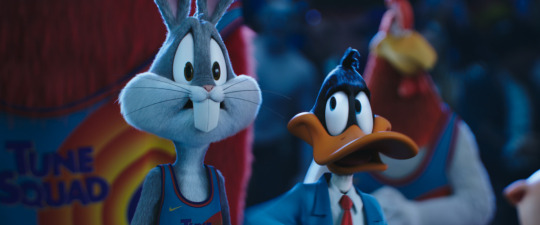
‘Space Jam: A New Legacy’ is in cinemas and on HBO Max now.
Craft is of course important, but generally speaking, maybe nowadays a commitment to silliness and a sincere love for the medium’s history is the thing that makes successful live-action/animation hybrids click. It’s an idea that doesn’t lend itself to being too cool, or even entirely palatable. The trick is to be as fully dotty as Mary Poppins, or steer into the gaucheness of the concept, à la Roger Rabbit and Looney Tunes: Back in Action.
It’s quite a tightrope to walk between good meta-comedy and a parade of references to intellectual property. The winningest strategy is to weave the characters into the tapestry of the plot and let the gags grow from there, rather than hoping their very inclusion is its own reward. Wait, you said what is coming out this week?
Related content
Rootfish Jones’s list of cartoons people are horny for
The 100 Sequences that Shaped Animation: the companion list to the Vulture story
Jose Moreno’s list of every animated film made from 1888 to the present
Follow Kambole on Letterboxd
#kambole campbell#mary poppins#ralph bakshi#hayao miyazaki#ghibli#disney#who framed roger rabbit#roger rabbit#spongebob squarepants#spongebob#animation#live action animation#live action animation hybrid#stop motion animation#stop motion#wes anderson#brad pitt#bob hoskins#genre#space jam#space jam a new legacy#michael jordan#lebron james#looney tunes#bugs bunny#daffy duck#warner bros#2d animation#letterboxd
25 notes
·
View notes